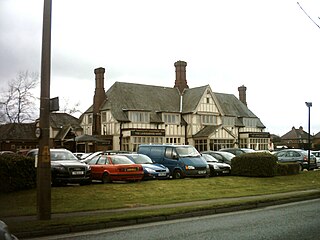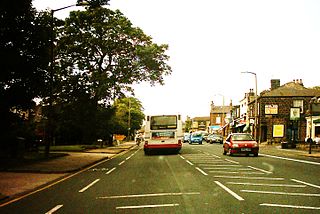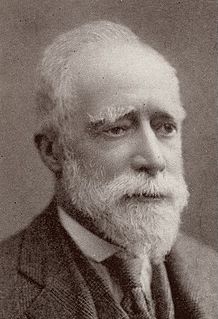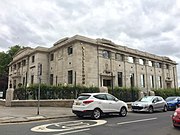
Otley is a market town and civil parish at a bridging point on the River Wharfe, in the City of Leeds metropolitan borough in West Yorkshire, England. Historically a part of the West Riding of Yorkshire, the population was 13,668 at the 2011 census. It is in two parts: south of the river is the historic town of Otley and to the north is Newall, which was formerly a separate township. The town is in lower Wharfedale on the A660 road which connects it to Leeds.

Headingley is a suburb of Leeds, West Yorkshire, England, approximately two miles out of the city centre, to the north west along the A660 road. Headingley is the location of the Beckett Park campus of Leeds Beckett University and Headingley Stadium.

West Park is a suburb of north-west Leeds, West Yorkshire, England, north of Headingley. It is a mixed area of private suburban housing and suburban council estates. The name derives from its main park containing playing fields together with a conservation area of grassy meadow ending in woodland. The largest housing estate in West Park is Moor Grange.

Holt Park is a medium-sized low-rise 1970s housing estate in the northwest suburbs of Leeds, West Yorkshire, England. It is approximately 6 miles (10 km) from Leeds city centre situated between Tinshill, Cookridge and Adel, and is at the edge of the Leeds urban fringe, bordering the green belt which makes up two thirds of the metropolitan borough of the City of Leeds. The nearby Tinshill BT Tower dominates the skyline.

Adel is a northern suburb of Leeds, West Yorkshire, England. To its immediate south is Weetwood, to the west are Cookridge and Holt Park, to the east are Alwoodley and Moortown, and to the north are Bramhope, Arthington and Eccup.

Bramhope is a village and civil parish in the City of Leeds metropolitan borough, West Yorkshire, England, north of Holt Park and north east of Cookridge.

Leeds Girls' High School (LGHS) was an independent, selective, fee-paying school for girls aged 3–18 founded in 1876 in Headingley, Leeds, West Yorkshire, England. It merged with Leeds Grammar School in 2005 to form The Grammar School at Leeds.

The Grammar School at Leeds (GSAL) is an independent fee-charging school in Leeds, England, created on 4 August 2005 by the merger of Leeds Grammar School and Leeds Girls' High School.

Cuthbert Brodrick FRIBA was a British architect, whose most famous building is Leeds Town Hall.

The Otley Run is a pub crawl in Leeds, West Yorkshire. The route shares much in common with the Headingley Mile but usually incorporating more pubs on the A660 road, typically those towards Leeds City Centre.

Skyrack was a wapentake of the West Riding of Yorkshire, England. It was split into upper and lower divisions and centred in Headingley, Leeds. The Lower Division included the parishes of Aberford, Bardsey, Barwick-in-Elmet, Kippax, Thorner, Whitkirk and part of Harewood, while the Upper Division included the parishes of Adel, Bingley, Guiseley and parts of Harewood, Ilkley and Otley.

Lawnswood is a small suburb in the north west of the city of Leeds in West Yorkshire, England. As such it is north north east of the West Yorkshire Urban Area. The suburb falls within the Adel and Wharefdale Ward of the City of Leeds Council.

Far Headingley is an area of Leeds, West Yorkshire, England approximately 3 miles (5 km) north of the city centre. The parish of Far Headingley was created in 1868.

The A660 is a major road in the Leeds and Bradford districts of West Yorkshire, England that runs from Leeds city centre to Burley-in-Wharfedale where it meets the A65. The A660 is approximately 10 miles (16 km) long, and crosses the watershed from Airedale to lower Wharfedale. For most of its length the road is in the metropolitan district of the City of Leeds; the last 0.4 miles (0.6 km) is in City of Bradford district.

Headingley Parish Church or the Parish Church of St Michael and All Angels in Headingley, a suburban area of Leeds, West Yorkshire, England is a large Victorian Church of England parish church in the centre of the parish on Otley Road.

George Corson (1829–1910) was a Scottish architect active in Leeds, West Yorkshire, England.

The architecture of Leeds, a city and metropolitan borough in West Yorkshire, England, encompasses a wide range of architectural styles and notable buildings. As with most northern industrial centres, much of Leeds' prominent architecture is of the Victorian era. However, the City of Leeds also contains buildings from as early as the Middle Ages such as Kirkstall Abbey, one of Britain's best preserved ruined Cistercian monasteries, as well as examples of 20th century industrial architecture, particularly in the districts of Hunslet and Holbeck.

The Lupton family in Yorkshire achieved prominence in ecclesiastical and academic circles in England in the Tudor era through the fame of Roger Lupton, provost of Eton College and chaplain to Henry VII and Henry VIII. By the Georgian era, the family was established as merchants and ministers in Leeds. Described in the city's archives as "landed gentry, a political and business dynasty", they had become successful woollen cloth merchants and manufacturers who flourished during the Industrial Revolution and traded throughout northern Europe, the Americas and Australia.

The Shire Oak was an ancient tree that stood in Headingley, now a suburb of the city of Leeds. It is thought to date from the time of the Danelaw in 9th-century England and is a shire oak, a tree that was used as a meeting point for local assemblies. The wapentake in this area was known as the Skyrack wapentake after the tree. The Shire Oak was felled by winds in 1941 and a plaque now marks the place in which it once stood.
Headingley is a ward in the metropolitan borough of the City of Leeds, West Yorkshire, England. It contains 111 listed buildings that are recorded in the National Heritage List for England. Of these, two are listed at Grade II*, the middle of the three grades, and the others are at Grade II, the lowest grade. The ward is to the northwest of the centre of Leeds, and is largely residential. As Leeds became more prosperous in the 19th century, the area developed to become "the prime residential area of Leeds". Most of the listed buildings are houses and associated structures, many of the houses are large, and some were used later for other purposes. The other listed buildings include churches and associated structures, public houses, remaining structures from the Leeds Zoological and Botanical Gardens, a cinema and lamp post, a war memorial, and a group of telephone kiosks.
























